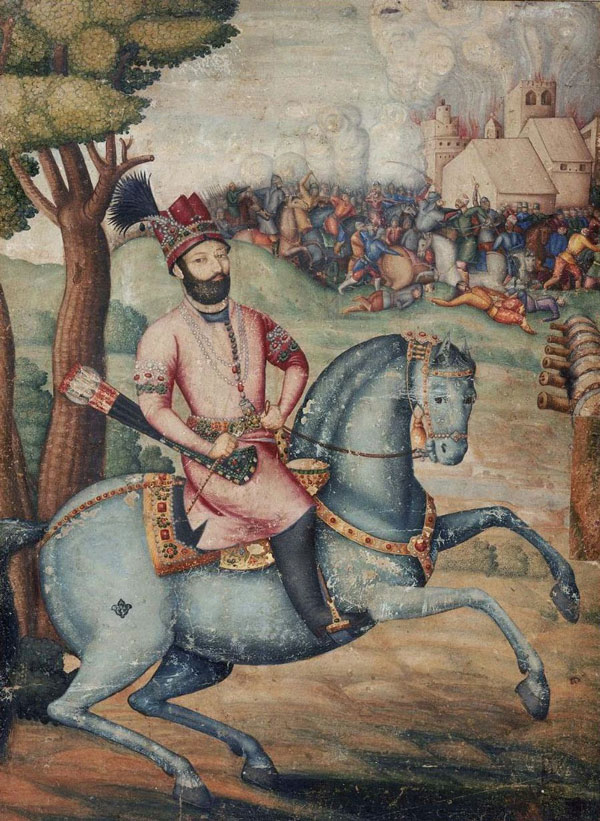The lost art of Urdu poetry: Shahr Ashob was a lament for a city

If we were to go by popular Urdu poetry we read and listen to, we'd probably think the poets lived in oblivion of their surroundings and the sufferings around them.
In actual fact Urdu poetry has a genre for almost every circumstance and for every aspect of the human condition.
One such less-examined genre in Urdu poetry is the shahr ashob or city disturber.
In Turkish and Persian poetry, the city 'disturber' was usually a young boy engaged in a trade or craft who 'coquettishly offers his wares to the lovestruck poet' says Persianate and Comparative Literature historian Sunil Sharma.
It thus became a valuable chronicle of crafts prevalent in the era, he says.
Roots in another time
It started, according to him, with Masud Sa'd Salman (1121 AD), the first to write shahr ashob.
In 18th century India, however, there was a socio-political shift and it changed form, evolving into a lament for the city.
"Urdu shahr ashob began at the start of the eighteenth century. After the death of Aurangzeb (1707), frightful shadows of decadence [zaval] and adversity began to loom in every direction.
Thus the genre of poetry which in Persian and Turkish was especially used for intellectual enjoyment, became in Urdu a vehicle for the description of political, economic, and social disturbances," says Dr Naim Ahmad.
This genre is a historical record of its times. It reflects the change in society. While royal scribes documenting 'history' were measured in their response, the poets were not.
It recorded the economic crisis of the previously prosperous Empire and post-1857, the change in status of royalty and nobility.
There are shahr ashob written by Shakir Naji, who was in the army of the Mughal Emperor Mohammad Shah when it was defeated in Karnal. He wrote a long shahr ashob on the impact of the military defeat on the Empire, nobility and society.
Then there is one shahr ashob by Qaim Chandpuri that blasts the Mughal Emperor Shah Alam II who took the help of the Marathas to defeat the Rohilla, Zabita Khan in the battle of Sarkartal in 1772.
Kaisa yeh Shah ke zulm pe uski nigah hai
Haathon se uske ek jahan dadkhah hai
Luchha ek aap saath looter sipah hai
Namus e khalq sa'e mein uske talab hai
Shaitan ka yeh zil hai naa Zill e Ilahi
-
What kind of King is he who is intent on injustice?
An entire world is protesting against him
A lout himself, has a brigand army
The honour of the people is defiled by his rule
He is the shadow of Satan, not the shadow of God*
(From http://www.columbia.edu/itc/mealac/pritchett/00urduhindilinks/txt_sharma_shahrashob_2004.pdf)
It was a genre in which Mir Taqi Mir and Mohd Rafi Sauda excelled.
Bloody events and a poetic outcome
The aftermath of Ahmed Shah Abdali's sack of Delhi and the fall of Delhi into British hands in 1857 has produced some gems of Urdu poetry.
1739 saw the sack of Delhi by the Persian invader Nadir Shah.

Nadir Shah at the sack of Delhi. Credit: Museum of Fine Arts, Boston
It is said that he saw the massacre from Sonehri Masjid in Chandni Chowk. A gate near it, now no longer extant, was named Khooni Darwaza because of that.
Mohammad Rafi Sauda writes after Nadir Shah's invasion:
Jahanabad tu kab iss sitam ke qabil tha
Magar kabho kisi aashiq ka yeh nagar dil tha
Ke yun mita diya goya ke naqsh e batil tha
Ajab tarah se yeh bahr e jahan mein sahil tha
Ke jis ki khaak se leti thi falak moti roll
Jahanabad you were never deserving of such tyranny
-
You were once the heart of lovers, many
Why has it been destroyed as if a lie by destiny?
T'was a wondrous beach in the sea of plenty
Precious stones on your shores galore
Mir Taqi Mir had to leave Delhi for Lucknow in search of employment and his shahr ashob reflects the economic devastation of Delhi:
Marne ke martabe mein hain ahbaab
Jo shanasa mila so be asbaab
Tangdasti se sab bahaal kharab
Jis ke hai baal, tau nahin hai tanaab
Jiske hain farash, tau nahin hain faraash
My friends all seemed to death, near
Whoever I met had lost all possessions, once so dear
Poverty seems to be a cross all have to bear
If one had a thread, no rope was in sight here
If one had a carpet, there were none to roll it out
These four months saw murder and mayhem, first of the British and Europeans by the rebellious sepoys and then by the British.

Two sepoys of the 31st Native Infantry who were hanged in Lucknow in 1857. Photo: Felice Beato
The wrath of the victorious British fell on the citizens of Shahjahanabad with those who weren't killed fleeing the city. The Timurid family who lived inside the Qila e Moalla fled for their lives, many were captured and killed, many turned into menial servants by the British.
Mufti Sadruddin Azurda who held the post of Sadr e Delhi wrote in shocked disbelief.
Zewar almas ka tha jin se na pahna jata
Bhaari jhumar bhi kabhi sir pe na rakhha jaata
Sar pe bojh liye chaar taraf phirte hain
Do qadam chalte hain mushkil se tau phir girte hain
Those frail ladies, are made to carry heavy loads, alas
They can barely walk a few steps before they fall down
The delicate ones who couldn't carry the weight of precious gems
For whom heavy jewellery was a burden too heavy







![BJP's Kapil Mishra recreates Shankar Mahadevan’s ‘Breathless’ song to highlight Delhi pollution [WATCH] BJP's Kapil Mishra recreates Shankar Mahadevan’s ‘Breathless’ song to highlight Delhi pollution [WATCH]](https://images.catchnews.com/upload/2022/11/03/kapil-mishra_240884_300x172.png)

![Anupam Kher shares pictures of his toned body on 67th birthday [MUST SEE] Anupam Kher shares pictures of his toned body on 67th birthday [MUST SEE]](https://images.catchnews.com/upload/2022/03/07/Anupam_kher_231145_300x172.jpg)






